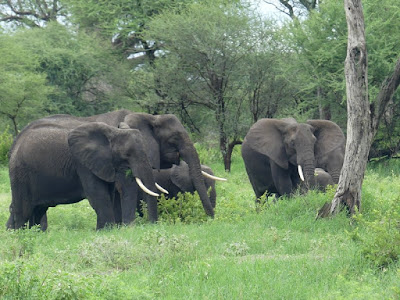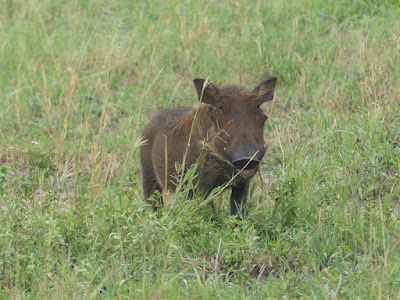We're just back from a scintillating five weeks in Tanzania, Kenya and South Africa, and of course I'll be sharing some of its delights with you in the coming months. It was my first time east of Uganda, and a great deal was new. The first reserve we visited was Tarangire National Park in the northern highlands of Tanzania, less than 150km from the city of Arusha, which is the gateway to Tanzania for many visitors. We found it a truly excellent introduction to east Africa, and that impression remained even after we later visited the more famous wonders of Serengeti and Ngorongoro Crater (both to the north-west on the Kenyan border). As soon as we entered the park we encountered two mighty Africans for which Tarangire is renowned.
 |
| Two wonderful African giants which characterise Tarangire - elephants under an African Baobab Adansonia digitata. |
In this post I'll introduce the landscape of Tarangire and some of the mammals we encountered; it is also noted for its bird wealth, which I'll talk about next time. Here are some photos which I hope can give an impression of the park, which is huge - 285,000 hectares.
 |
| Looking out over some of the vast plains, supporting a grassy savannah with a covering of acacias (notably Umbrella Thorn Acacia or Vachellia tortilis) and Combretum spp. in particular. |
In drier sections succulents, including tree-sized ones, appear.
 |
| Euphorbia sp. |
 |
| Combretum sp. and African Baobabs. |
Tarangire is not uniformly flat however, with an altitude ranging from 1000 to 1500 metres above sea level.
 |
| Crossing a range of hills to look into the distance over the plains. |
The park takes its name from the Tarangire River which flows through it from south to north, ending in Lake Barunge (or Burungi) on the park's north-western boundary.
Actually the seasons aren't quite as simple as that statement suggests - the northern Tanzanian highlands have two wet seasons, from March to May and again from October to December.
Another important aspect of Tarangire's ecology is the presence of extensive swamps (or perhaps flood plains) down the eastern side of the park.
 |
| Looking out over Silale Swamp. |
And of course these grassy woodland landscapes support a huge biomass of grazing and browsing animals. Let's start (or continue) with the elephants for which Tangarire is famed.
 |
| Elephants in the Tangarire landscape. |
It is a very special experience to be close to these massive animals, in a vehicle with lifting top, with guides (in our case a Tanzanian and a South African) who know and understand them.
 |
| It is somewhat unnerving to be this close, and you need reliable guides to do it safely. This young male wasn't very interested in us actually, he just wanted to graze there. |
He was actually close enough that a couple of ticks on his underside were quite evident!
His domed head contrasts nicely with the characteristically angled forehead of a female, as shown below.
 |
| Male above, and female below. |
 |
| It is hard to imagine how much grass and foliage even a relatively small herd like this must consume every day. The wicked acacia thorns don't seem to deter them either. |
 |
| Red elephants can be a bit of a shock initially, but the colour reflects their love of a good mud wallow. |
Of course the elephant aren't the only one devouring the grass either.
 |
| Impala Aepyceros melampus are a constant in the landscape; this is a female herd. |
 |
| Impala male. Only he has the horns. A male will try to hold a territory, in which he hopes to amass a harem of females like the herd above. |
 |
| Pair of Grant's Gazelle Nanger (Gazella) granti.In this species the female does have horns, though his are much larger. |
 |
| Waterbuck Kobus ellipsiprymnus, a big antelope; male above, female and calf below. |
 |
| These show the characteristic 'sat on a painted toilet seat' rump markings of the species. |
 |
| Plains (or Burchell's) Zebra Equus quagga also place quite a pressure on the park's grasses. This is the commonest and most widespread of the three zebra species. |
 |
| Group of curious foals; it's always a delight to come round a corner and encounter these lovely animals. |
Another eternal delight is any encounter with the extraordinary Giraffe Giraffa camelopardalis.
 |
| Common Warthogs Phacochoerus africanus tend to be wary, but family groups scampering through the grass with erect tails are a common sight. |
 |
| Unstriped Ground Squirrel Xerus rutilus, a dweller of dry savannahs of north-east Africa. |
A mammal group which fascinates me (and gives me great pleasure) is the hyraxes, not least because of the knowledge that their closest relatives (albeit still distant!) are elephants and manatees...
 |
| Yellow-spotted Rock Hyraxes (or Bush Hyraxes) Heterohyrax brucei shelter under a roadside rock overhang. |
 |
| Common Agama Agama agama. These spectacular males fight vigorously for mating rights; this may have been the cause of this one's truncated tail. |
On the other hand of course, Tarangire supports many predators, from small to very large.
One of my highlights from the visit was my first ever wild Cheetahs, a mother and three young cubs, some distance off the road (at least 100 metres).
 |
| Initially the family was resting near a thorn tree, but eventually she led them further from the road. |
We were extraordinarily lucky this trip with Cheetahs, generally reckoned to be 'difficult' in most places; in the end we saw 11 of them, spread across four parks. Remarkable.
And just as we were about to leave Tarangire, it produced a classic Africa scene, with a pride of Lions finishing off last night's kill - a young buffalo.
 |
| These two big youngsters were resting by the water, having presumably fed, until their attention was taken by something in the tree above... |
 |
| The Nile Monitor seemed to appreciate that there was no point in coming down for some time. |
Nearby the rest of the family was finishing off the meal.
 |
| The male, who would have fed first, was doubtless lying and digesting somewhere nearby. |
Sadly for them, happily for us, Tarangire is not a heavily visited park, as people with tight schedules either pop in for a day visit, or skip it altogether on their way to Serengeti. Having seen both, I am adamant that that would be a big mistake and one that I hope you don't ever make! Next time I'll be back with a sample of Tarangire's remarkable bird life.
NEXT POSTING THURSDAY 4 JULY
(And remember that you can get a reminder when the next post appears by putting your email address in the Follow by Email box in the top right of this screen.
And I'd love to receive your comments - it's easy and you don't need to sign in!)
(And remember that you can get a reminder when the next post appears by putting your email address in the Follow by Email box in the top right of this screen.
And I'd love to receive your comments - it's easy and you don't need to sign in!)











